Field Meeting Reports
Hersham Bird Ringing Group Saturday 3 August 2024
13 members were treated to an excellent and very informative morning with the Hersham Bird Ringing Group based at the Queen Mary Reservoir, Ashford.
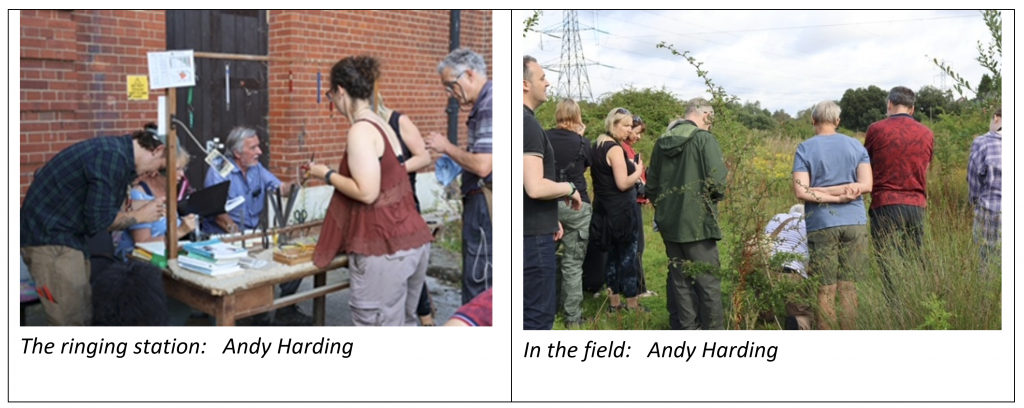
We were first shown some of the birds the Group had caught just before we arrived, including young Blackcaps, a Willow Warbler, Chiffchaff and a fairly aggressive juvenile Blue Tit! Surprisingly Blackcaps were currently the most abundant bird to be caught. It was a real privilege to see up close the difference between a Chiffchaff and a Willow Warbler – the much yellower plumage of the juvenile Willow Warbler self-evident. After a very informative briefing as to the history of the Group, how data is collected and recorded, changing bird numbers over the years and answering a myriad of questions, we were taken on a tour of the site visiting a number of mist net positions.
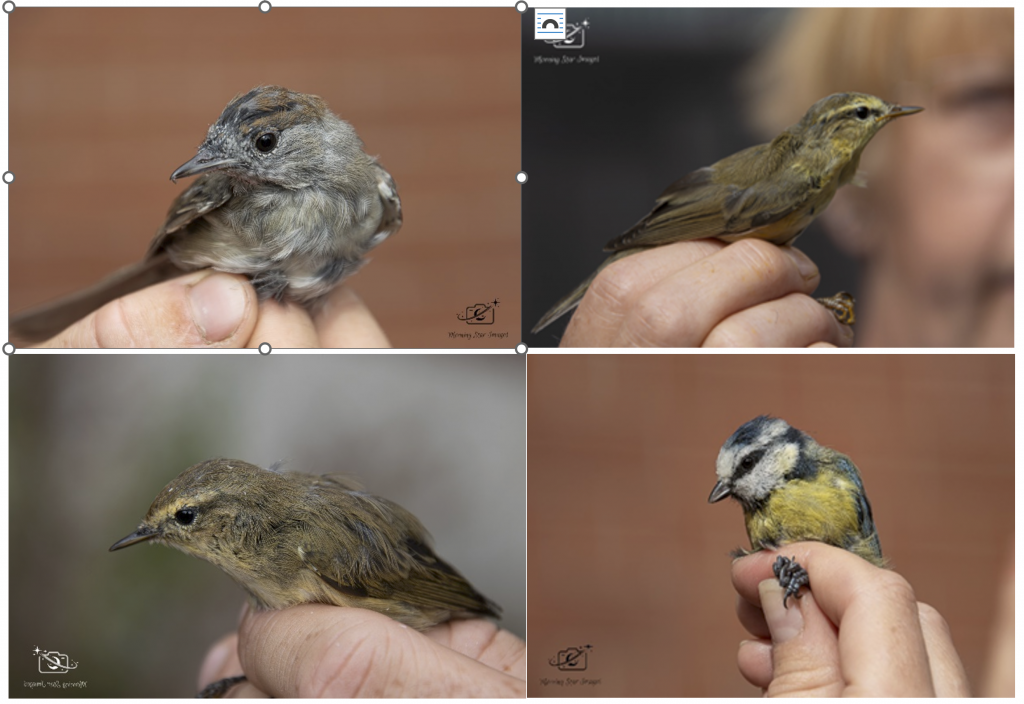
(Blackcap, Willow Warbler, Chiffchaff and Blue Tit: Gail Huckle)
We were treated to the site of the adult Hobbies (recently nested) harassing a Red Kite over the Reservoir as we walked the site. Returning to the Ringing Station, further birds were collected and processed. Those caught and ringed were Eurasian Blue, Tit, Great Tit, Willow Warbler, Common Chiffchaff, Blackcap, Common Whitethroat, Common Reed Warbler, Eurasian Wren, Robin and Dunnock.
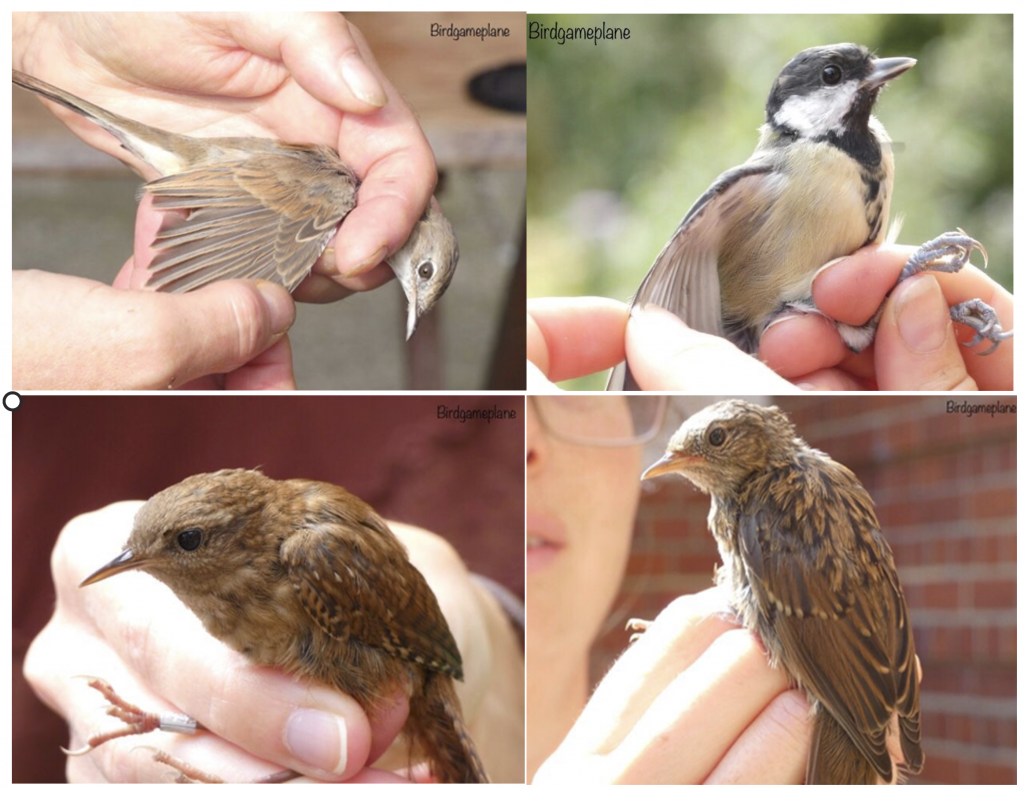
(Common Whitethroat, Great Tit, Eurasian Wren and Dunnock: Jack Taylor)
We finished our morning with a walk up the steps to view the Reservoir – what a view! Other than the Hobbies (which were ever present), we had a Common Sandpiper close by with Mute Swans, Great Crested (many) and Little Grebes, rafts of Tufted Ducks and Coots and a large group of Egyptian Geese on the far bank.
A very enjoyable morning. Huge thanks to Tony Beasley and his colleagues at the Hersham Bird Ringing Group for giving up their time and imparting their knowledge and expertise. Whilst this was not a usual birding trip, for the record, we recorded 30 species during the morning:
| Canada Goose | Eurasian Coot | Eurasian Hobby | Eurasian Blackcap |
| Mute Swan | Common Sandpiper | Common Magpie | Common Whitethroat |
| Egyptian Goose | Black-headed Gull | Carrion Crow | Eurasian Wren |
| Mallard | Herring Gull | Eurasian Blue Tit | European Robin |
| Tufted Duck | Lesser Black-backed Gull | Great Tit | Dunnock |
| Little Grebe | Great Cormorant | Common Reed Warbler | Common Linnet |
| Great-crested Grebe | Red Kite | Willow Warbler | |
| Feral Pigeon | Great spotted Woodpecker | Common Chiffchaff |
Andy Harding
Papercourt Saturday 6th July 2024
20 people met in the Tannery Lane Car Park on a blustery and showery morning.
We walked back down the lane, with a ploughed field to our right, and, scanning the field, could see Stock Doves feeding and a single Red-Legged Partridge hunkered down on the ground, avoiding the wind.At the end of the path, we walked through the trees to our right, seeing a Red Kite gliding over the field through the trees. Turning down the path to the left we were sheltered from the wind, and the sun was warming; a woodpecker could be heard in the trees to our left, and looking into the private area we saw a rather obscure bird sunning itself in the branches of a tree. On closer inspection (with a scope) it turned out to be a Jay.
We reached the sailing club and lake, and could immediately see what looked like an extended family of Egyptian Geese on the shore, with birds of various ages. Continuing along the path, Common Terns were seen flying by, as well as a Kestrel hovering and later perched conveniently on a nearby post. There was a good view of a singing Whitethroat, and Canada Geese and Great Crested Grebe were seen on the lake. Moving onto the path, perpendicular to the lake, we walked towards Papercourt Lock.

Kestrel Gail Huckle
Swifts and Goldfinches were seen flying around and overhead, and a sharp-eyed member spotted a juvenile Green Woodpecker sitting on the ground in the field to our right. Looking upwards, a large-winged bird was seen circling, and closer inspection revealed a grey heron on the wing.
Nearing the lock area, there were Chiffchaffs in the nearby bushes and a Buzzard was seen being attacked by two Crows and ejected from nearby trees. Swallows and House Martins were skimming the field to our right and a couple of Reed Buntings made a brief appearance in bushes to the left. Walking over the bridge by the lock a Grey Wagtail took to the wing, and somebody was lucky enough to catch a glimpse of a Kingfisher as it flashed past and into a canal-side tree. On the final leg of the walk between the River Wey and Papercourt Meadows, the weather deteriorated a little but we were lucky to catch sight of a solitary Stonechat perched on grass stem deep in the meadow. Overall, an enjoyable walk with 34 species seen.
| Green Woodpecker, | White throat | Canada Goose, | Egyptian Goose, |
| Kingfisher, | Red Kite, | Common Buzzard, | Carrion Crow, |
| Jackdaw, | Reed Bunting, | Stonechat, | Red-legged Partridge, |
| Stock Dove, | Woodpigeon, | Chiff Chaff, | Swift, |
| House Martin, | Swallow, | Mallard Duck, | Tufted Duck, |
| Great Crested Grebe, | Jay, | Starling, | Grey Wagtail, |
| Grey Heron, | Goldfinch, | Kestrel, | Common Tern, |
| Herring Gull, | Coot, | Moorhen, | Wren, |
| Blue Tit, | Great Tit. | ||
Ed Hilton
Thursley Common Wednesday 19th June 2024
With the lack of Nightjar sightings at our May outing, it was decided to make amends with a further visit in mid-June, when the Thursley Nightjars would be in full song and active before nightfall. Incredibly we had 42 attendees, keen to hear and see these crepuscular and extraordinary birds on one of the most iconic Surrey heaths. Almost immediately, a very distant Hobby was identified with scope views through the trees – a great spot! Later at the top of Shrike Hill, better views of this superb summer falcon were also had.
Taking the same route as the May outing, circumventing the main bog, and heading to the back of Shrike Hill via the sandy paths, the air was full of the Willow Warbler’s descending and slightly melancholy song. Most of the group managed to first hear and then see the skulking Dartford Warblers and fortunately two very obliging Tree Pipits sang from clear vantage points. Walking over Shrike Hill and along the boardwalk through Pine Island, we stopped off at Pudmore Pond for any wildfowl and, possible waders, but other than the usual Canada Geese, Mallard and Tufted Duck there was nothing notable.
Stepping off the boardwalk, we all stood expectantly, along the sandy path close to the telegraph lines and within 10 minutes, the first Nightjar started churring. It wasn’t long before wing clapping and frog-like grunts helped locate the bird, moving through and behind the nearby trees. We were then all treated to some great views of probably up to four birds working their way around the woodland, over the path and bog into nearby trees where better views could be had.
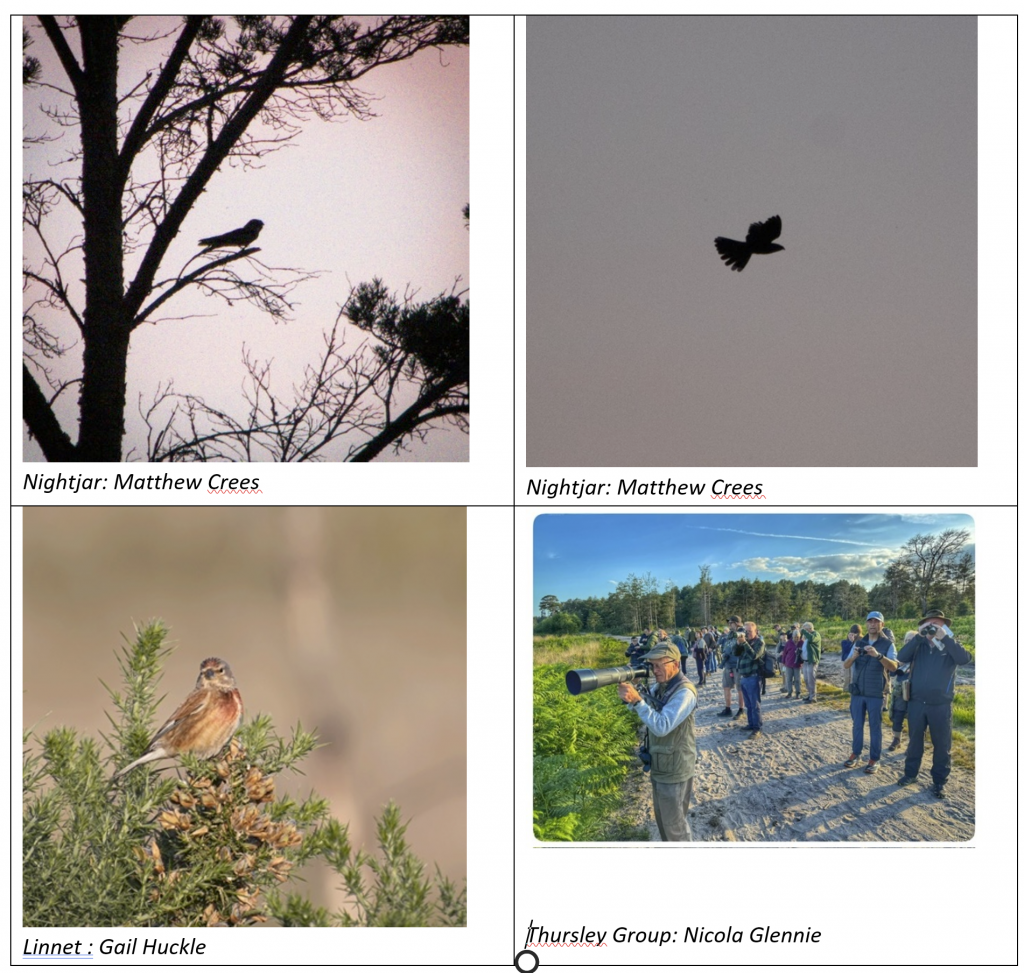
My personal highlight was the unexpected Curlew flying high above us going into the Common, just before nightfall. An excellent evening’s birding with, despite only 20 species being seen, most of the target Surrey heathland birds being found.
| Canada Goose | Eurasian Curlew | Barn Swallow | European Robin (h) |
| Mallard | Great Spotted Woodpecker | Willow Warbler | European Stonechat |
| Tufted Duck | Eurasian Green Woodpecker | Common Chiffchaff | Tree Pipit |
| Common Woodpigeon | Eurasian Hobby | Dartford Warbler | Common Linnet |
| Eurasian Nightjar | Carrion Crow | Eurasian Wren | European Goldfinch |
Andy Harding
Thursley Common Thursday 9th May 2024
With 23 intrepid birders out for an evening’s stroll around the magnificent Thursley Common, thoughts were for Nightjars, Woodcock, Dartford Warblers, Redstarts and Tree Pipits. Sadly not all the iconic heathland birds showed but nevertheless we all enjoyed a very successful walk. Heading our customary “right” at the base of the boardwalk, taking an anti-clockwise route to the rear of Shrike Hill, over the top and then settling near the main boardwalk to hopefully see our main quarry – the Eurasian Nightjar.
The birdsong was superb with Willow Warblers, Common Redstarts, clicking Stonechats and the repetitive song of the Chiffchaff ringing out. Stopping to look over the heathland, we all managed views of both singing and displaying Woodlark (we had up to six around the Common) and the elusive Dartford Warbler – now quite common at Thursley, but still a real thrill to locate one. As we were about to head up behind Shrike Hill, someone shouted “Cuckoo” and sure enough the falcon-like silhouette moved across the sky and just above the woodland canopy – great spot given it wasn’t calling. Very good views of Tree Pipit and Woodlark were had and some managed to find the unusually shy Common Redstart.
We got to the Nightjar spot slightly early; so we headed to Pudmore Pind via the boardwalk, and picked out Canada and Egyptian Geese, Mallard, Tufted Duck and Eurasian Coot. Sadly despite a long wait, we clearly had mis-timed our visit by a few days as no Nightjars appeared or were heard and disappointingly the normally guaranteed Woodcock also failed to show.
This did not stop everyone having a great visit and meant an excuse for a further visit in June. An excellent evening’s birding with 30 species being seen.
| Canada Goose | Grey Heron | Barn Swallow | Eurasian Blackbird |
| Egyptian Goose | Great Spotted Woodpecker | Willow Warbler | European Robin |
| Mallard | Common Kestrel | Common Chiffchaff | Common Redstart |
| Tufted Duck | Eurasian Jay | Eurasian Blackcap | European Stonechat |
| Common Pheasant | Carrion Crow | Common Whitethroat | Tree Pipit |
| Common Woodpigeon | Eurasian Blue Tit | Dartford Warbler | European Goldfinch |
| Common Cuckoo | Woodlark | Eurasian Wren | |
| Eurasian Coot | Eurasian Skylark | Mistle Thrush |
Andy Harding
RSPB Pulborough Brooks Saturday 20th April 2024
A full morning of birding with some Surrey Bird Club members attending the RSPB-organized Dawn Chorus meeting at 04.30hrs; the main group then meeting at 08.30hrs for a full walk around this fantastic reserve. Other than a Cuckoo calling just after 5am, all birds heard and seen on the early excursion were later seen (or heard) later in the morning.
The stars of the show were the Nightingales, who not only performed beautifully singing from the scrub along the Zig-Zag path but almost in all locations around the reserve, and showed really well as evidenced by the photo. Scanning the South Brooks from the viewpoint by the Visitor Centre, we could make out a Great Egret, together with displaying Lapwings, noisy Black-headed Gulls, both Canada and Greylag Geese, and Shelduck busying themselves in the fringes.

Splitting into two groups from the bottom of the Zig-Zag, so as not to overload the hides, everyone got to see a majority of the birds listed. Despite the increasingly chilly weather, the summer migrants were now on the reserve in force with the warblers and Nightingales singing continually – Chiffchaff, , Common Whitethroat, Eurasian Blackcap, Sedge Warbler togetrher with the ubiquitous Cetti’s Warbler (even allowing a few glimpses of one in amongst the scrub.
From West Mead and Winpenny Hides, there were still good numbers of wildfowl about with Shelduck, Teal, Egyptian Geese (with young), Gadwall, a pair of very late Pintail and Tufted Duck, with a good number of displaying Redshank calling over the scrapes and meadows. It was heartening to find 3 pairs of Avocet on the reserve, with one seen on a nest. Few other waders were seen apart from the summer-plumaged Black-tailed Godwit from Hanger Viewpoint and 3 Ringed Plovers from Winpenny.
Raptors were represented by a superb Kestrel hovering in the wind directly in front of one group at Hanger, with a female Marsh Harrier together with a number of Common Buzzards and Red Kites seen around the trails. Sadly neither the resident Peregrine nor the pair of White-tailed Eagles were present (enough reason to arrange another visit in the winter). It wasn’t just the warblers and Nightingales that filled the airways with song – Linnets, Greenfinch Dunnock, Blue, Great and Longtailed Tits, Robin, Wren and Blackbird all were in full voice and showing really well.

Three regulars were also seen by some – the Stonechat pair between Winpenny and West Mead, Reed Buntings at Netley’s Hide, the male Grey Wagtail by the pond at the bottom of the Zig-Zag and the Adders in the enclosed area by the Visitor Centre.
So many birds and sounds on the Reserve that know everyone had a very enjoyable morning with 65 species being seen or heard (h).
| Greylag Goose | Common Ringed Plover | Rook | Song Thrush |
| Canada Goose | Northern Lapwing | Carrion Crow | Eurasian Blackbird |
| Mute Swan | Black-tailed Godwit | Eurasian Blue Tit | European Robin |
| Egyptian Goose | Common Redshank | Great Tit | Common Nightingale |
| Common Shelduck | Black-headed Gull | Eurasian Skylark | European Stonechat |
| Northern Shoveler | Herring Gull | Sedge Warbler | Dunnock |
| Gadwall | Great Cormorant | Sand Martin | House Sparrow |
| Mallard | Little Egret | Barn Swallow | Grey Wagtail |
| Northern Pintail | Great Egret | Common Chiffchaff | Pied Wagtail |
| Eurasian Teal | Grey Heron | Cetti’s Warbler | Common Chaffinch |
| Tufted Duck | Western Marsh Harrier | Long-tailed Tit | European Greenfinch |
| Common Pheasant (h) | Red Kite | Eurasian Blackcap | Common Linnet |
| Common Woodpigeon | Common Buzzard | Common Whitethroat | European Goldfinch |
| Common Cuckoo (h) | EurasianGreenWoodpecker (h) | Goldcrest | Common Reed Bunting |
| Common Moorhen | Common Kestrel | Eurasian Nuthatch | |
| Eurasian Coot | Common Magpie | Eurasian Wren (h) | |
| Pied Avocet | Eurasian Jackdaw | Mistle Thrush | PULBOROUGH |
Andy Harding
Dukes Warren, Leith Hill – Thursday 10th April 2024
For a mid-week walk it was great to have 22 members attend our first walk round beautiful Dukes Warren at the top of Leith Hill. Immediately on reaching the Coldharbour cricket club, we had superb views of a Woodlark feeding in the outfield, along with Song Thrush, Blackbird and Linnet. Taking the path behind the cricket clubhouse (great location for Ring Ouzel in the autumn), we were greeted by the beautiful sound of Willow Warblers singing from the alders and pines with their characteristic gentle, descending song.
As we were all remarking on their song, chattering birds overhead signalled the arrival of a large family group of Common Crossbills. Providing fantastic views, everyone got to see the beautiful colours of the male (red) and female (green) alongside the much duller brown juveniles. Over the course of the walk we counted 54 birds within the single group.
A Cuckoo was heard intermittently from within the valley but distant. Birdsong was everywhere with one bird taking centre stage – the Woodlark with a beautiful fluty song. counted up to six birds singing continually with a few taking to the skies with their almost bat-like flight We took the loop walk and were also rewarded with Stonechat, Common Buzzard (2), Chiffchaff, Blackcap and Siskin.

Probably the highlight was at the end of the walk, when we heard the Cuckoo again with one of the group locating the bird on the top of a tree – everyone getting great views of it. An excellent morning’s birding with 30 species being seen or heard (h)
| Mallard | Common Kestrel | Long-tailed Tit (h) | Eurasian Robin |
| Common Pheasant | Eurasian Jay | Eurasian Blackcap | European Stonechat |
| Stock Dove | Carrion Crow | Goldcrest | Common Chaffinch |
| Common Woodpigeon | Coal Tit | Eurasian Nuthatch | Common Linnet |
| Common Cuckoo | Eurasian Blue Tit | Eurasian Treecreeper (h) | Common Crossbill |
| Great Cormorant | Woodlark | Eurasian Wren | Eurasian Siskin |
| Common Buzzard | Willow Warbler | Song Thrush | |
| Great Spotted Woodpecker | Common Chiffchaff | Eurasian Blackbird | LEITH HILL |
Andy Harding
Hayling Oyster Beds – Saturday 9th March 2024
On a dry and bright morning, 11 birders travelled over “the bridge” to visit the famous Hayling Island Oyster Beds along the Hayling Billy Trail. For those that arrived early, a Little Egret greeted them along the immediate shoreline with Dark bellied Brent Geese, Mallard and Wigeon in the expanse of water in front of the car park, known as Bridge Lake.
Onto the Hayling Billy Trail and scanning the huge Langstone Harbour, we immediately were in awe as to the sheer number of birds to be seen. Large flocks of Red Knot, Dunlin and Grey Plover were wheeling around over the Harbour supplemented by smaller but very active groups of Turnstone, Oystercatcher and Redshank. High above, the continual characteristic call of the Mediterranean Gull (out-numbering the Black-headed Gulls considerably) added to the amazing experience.
A pair of Red-breasted Mergansers were close-in giving excellent views, with a small group of Wigeon and a couple of Great Crested Grebes in their breeding finery, close by. In al,l we saw around 8-10 of the mergansers during the walk
A superb spot saw us all focus on a large black and white bird some way out – a Great Northern Diver! We watched it for some time – continually diving then stopping to stretch and preen. This was one of three we saw around the harbour.
It was clear that most of the wildfowl had left but we still were able to admire the elegant Pintail at close quarters with a few still not having made the move to their breeding grounds. Further along the trail, someone found a Curlew; within the same vicinity, a Whimbrel was first heard overhead and then located, allowing us to compare the two birds almost in the same field of vision. We all could easily make out the Whimbrel with its more slender and slightly smaller body, a shorter bill but most noticeably the light brown median crown-stripe.
At this spot we were able to also pick out a single Greenshank and up to four Bar-tailed Godwits (noting the lack of a white wing-bar unlike the Black-tailed) and also seeing the difference in size of the Dunlin compared to the Red Knot.

The bird of the day was the very obliging female Long-tailed Duck which performed beautifully for us at very close quarters in front of the hordes of Mediterranean and Blackheaded Gulls, all arguing over the best sites! Passerines were actually hard to come by but we did have 4 or 5 Chiffchaffs, two very noisy Cetti’s Warblers and some good views of Greenfinches. Heard but not seen were a Water Rail, Wren, Dunnock and a Green Woodpecker. Almost back to the car park and in the final inland pool, a pair of Teal were seen along with a couple of Moorhens.
A truly great morning’s birding at a great location with a huge number birds, and with some great sightings coupled with superb company. We all agreed Hayling Island was to become a regular venue for the future calendar. An excellent morning’s birding with 47 species being seen or heard (h).
| Dark-bellied Brent Goose | Water Rail (h) | Black-headed Gull | Common Chiffchaff |
| Mute Swan | Common Moorhen | Mediterranean Gull | Cetti’s Warbler (h) |
| Eurasian Wigeon | Eurasian Oystercatcher | Common Gull | Long-tailed Tit |
| Mallard | Grey Plover | Herring Gull | Eurasian Wren (h) |
| Northern Pintail | Whimbrel | Great Black-backed Gull | Common Starling |
| Eurasian Teal | Eurasian Curlew | Great Northern Diver | Redwing |
| Long-tailed Duck | Bar-tailed Godwit | Great Cormorant | Eurasian Blackbird |
| Red-breasted Merganser | Common Redshank | Little Egret | European Robin (h) |
| Little Grebe | Common Greenshank | Green Woodpecker (h) | Dunnock |
| Great Crested Grebe | Ruddy Turnstone | Common Magpie | European Greenfinch |
| Feral Pigeon | Red Knot | Carrion Crow | European Goldfinch |
| Common Woodpigeon | Dunlin | Eurasian Blue Tit | HAYLING OYSTER BEDS |
Andy Harding
Unstead Wetlands Nature Reserve & Cutt Mill, Puttenham – Wednesday 21st February 2024
On a dreadfully wet morning, 12 intrepid Surrey Bird Club members and guests braved the elements to take in the superbly-managed and award-winning reserve at Unstead Wetlands. Our thanks to Janet Pizzey to taking us on a very insightful and informative tour of the reserve showcasing the excellent improvements in terms of the fantastic new wetland area and the associated viewing platform along with the on-going tree planting.
Meeting in the adjoining Thames Water treatment plant (again thanks to Janet for arranging for Thames Water to permit us access), we first took in the northern part of the Reserve looking over the River Wey water meadows. Canada Geese, Coot, a male Gadwall, a pair of Mandarins and a pair of Egyptian Geese with a brood of about 10 goslings was a very good start.
We stopped off at the beautifully equipped hide and feeding station, in the hope of seeing both Water Rail and Firecrest, but sadly neither obliged but did get great views of Blue, Great and Long-tailed Tit, plus Tufted Duck, Little Grebe and more Gadwall. Strolling back to overlook the new wetlands, Janet was able to provide an in-depth description of the earthworks funded by Thames Water and how the water levels were maintained on this part of the reserve. In the newly planted area we all got to see both Reed Bunting and Chiffchaff, and from the new platform we got very good views of the gulls and wildfowl on the mosaic of waterways. A Red Kite, Kestrel and Great Spotted Woodpecker were seen from this viewpoint.
In total 35 species were seen which was an excellent tally given the challenging weather conditions.
A majority of the party then headed off to Cutt Mill, Puttenham to (hopefully) catch up with Goosander, Mandarin Duck and potentially Kingfisher – well, 2 out of 3 was not bad! A group of 4 Goosanders was almost immediately seen heading off over the forest, which we thought might be end of our luck but thankfully we had another 6 females (red heads) on the main pond (Warren Pond). In our short walk we managed 9 species, bringing our total for the morning to 40 species:
Heading to Cutt Mill Pond (next to the large house) from the car park, we were very privileged to watch about 100 or so Siskins feeding voraciously in the alders above Suffield Lane between the two main lakes – what a sight! At the lake, there was a very good array of wildfowl with Mandarin Duck (3), Shoveler, Gadwall, Mallard, Eurasian Teal and Tufted Duck. A walk around Warren Pond gave us good views of both the Goosanders and 3 Great Crested Grebes, who were starting to get into their breeding finery.
| Canada Goose (u) | Little Grebe (u) | Common Kestrel | Song Thrush (u) |
| Egyptian Goose (u) | Great Crested Grebe (cm) | Common Magpie (u) | Eurasian Blackbird (u) |
| Mandarin Duck (u/cm) | Stock Dove (u) | Eurasian Jackdaw (u) | European Robin (u) |
| Northern Shoveler (cm) | Common Woodpigeon (u) | Carrion Crow (u) | Dunnock (u) |
| Gadwall (u/cm) | Common Moorhen (u) | Eurasian Blue Tit (u) | Pied Wagtail (u) |
| Mallard (u/cm) | Eurasian Coot (u) | Great Tit (u) | Common Chaffinch (u) |
| Eurasian Teal (cm) | Black-headed Gull (u) | Common Chiffchaff (u) | European Greenfinch (u) |
| Tufted Duck (u/cm) | Great Cormorant (u) | Long-tailed Tit (u) | European Goldfinch (u) |
| Goosander (cm) | Red Kite (u) | Goldcrest (u) | Eurasian Siskin (cm) |
| Common Pheasant (u) | Great Spotted Woodpecker(u) | Eurasian Wren (u) | Common Reed Bunting(u) |
Andy Harding
RSPB Rainham Marshes Nature Reserve – Sunday 4th February 2024
A new venue for the 2024 calendar and, with the introduction of car-sharing, we were able to get 17 members and guests to the Reserve as sustainably as we could – a feature of the field outings going forward. With the weather mild, overcast, but breezy our expectation was for a decent morning of birding – we were not let down.
Starting in an anti-clockwise direction, we scanned the nearby pools from the Visitor Centre path noting a good array of wildfowl with Mallard, Tufted Duck, Shoveler, Teal, Wigeon, Little Grebe and 3 Pintails (including an exquisite male in the main channel). Both Canada and Greylag Geese were prevalent across the reserve.
A female Kestrel was seen on a distant bush (great spot!) as we made our way to the Ken Barrett Hide, noting Redwings, Blue & Great Tits,and a singing Song Thrush and Dunnock. At this extensive hide, where we all got a seat (including some cushions!) we got excellent views of the key wildfowl, with a smart male Pochard stealing the show. Far away a female / immature Marsh Harrier was seen quartering the field near the wind turbines – one of at least 5 seen during our walk.
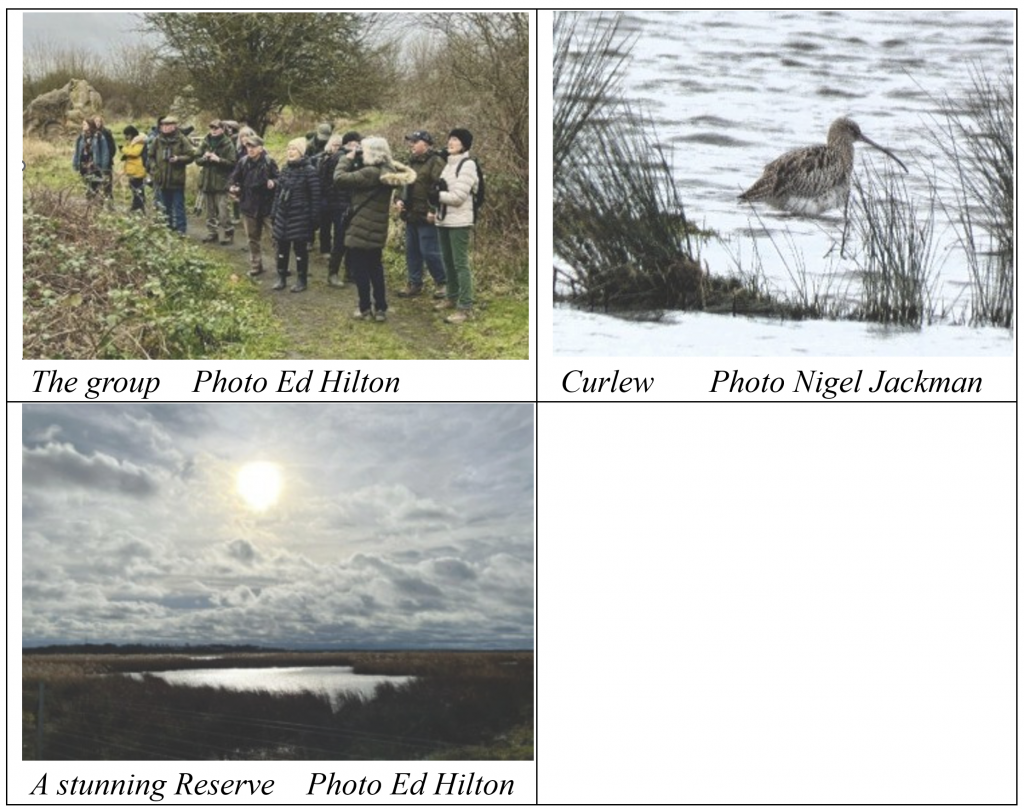
A long straight walk to the next hide gave us time to scan both the reed beds and the marsh / pools along this route. A singing Cetti’s Warbler, seemingly only feet from the path, characteristically did not give itself up despite 17 pairs of eyes looking intensely. Again good numbers of wildfowl to be seen together with a very active flock of Lapwing supported by a couple of Curlew, a group of Starlings and a few Fieldfares.
At the next hide, which was stunning with windows in all directions, we were able to scan all points picking up a number of Marsh Harriers including a handsome male, and eventually 3 Common Snipe were located skulking at the edge of reed fringe. As we made our way up to the Thames path, we had excellent views of a pair of Stonechat and two Meadow Pipits on the wire fencing.
A wild walk back to the car park in a strong westerly wind was worth the effort picking up 2 Rock Pipits, 4 Reed Buntings including 2 males, 5 Redshanks and on the south side of the Thames amongst the gulls, 5 feeding Avocets.
A thoroughly enjoyable morning at an impressive London reserve with some excellent sightings and equally excellent company. An excellent morning’s birding with 52 species being seen or heard (h)
| Greylag Goose | Common Woodpigeon | Great Cormorant | Song Thrush (h) |
| Canada Goose | Collared Dove | Redwing | Western Marsh Harrier |
| Common Shelduck | Common Moorhen | Common Kestrel | Eurasian Blackbird |
| Northern Shoveler | Eurasian Coot | Common Magpie | Fieldfare |
| Gadwall | Pied Avocet | Eurasian Jackdaw | European Robin (h) |
| Eurasian Wigeon | Northern Lapwing | Carrion Crow | Stonechat |
| Mallard | Eurasian Curlew | Eurasian Blue Tit | Dunnock |
| Northern Pintail | Common Snipe | Great Tit | House Sparrow |
| Eurasian Teal | Common Redshank | Eurasian Skylark | Pied Wagtail |
| Common Pochard | Black-headed Gull | Cetti’s Warbler (h) | Meadow Pipit |
| Tufted Duck | Herring Gull | Long-tailed Tit | Rock Pipit |
| Little Grebe | Great Black-backed Gull | Eurasian Wren (h) | European Goldfinch |
| Stock Dove | Lesser Black-backed Gull | Common Starling | Common Reed Bunting |
Andy Harding
WWT London Wetlands Centre – Sunday 7th January 2024
As is traditional, the first field outing of the year was to the London Wetlands Centre.
37 members and guests were keen to start their birding year with an excellent opportunity to see a good number of species in close proximity of the pathways and hides. Of particular note was the anticipation of seeing the reported Eurasian Bittern and male Bearded Tit – so we collectively decided to visit the Wildside first, giving us all the best opportunity of seeing these birds – we were not disappointed!
Walking through the captive collection, we passed through the gate into The Wildside and started out at the Headley Discovery Hide. A good selection of waterbirds was immediately identified including the usual wildfowl (Mallard, Gadwall, Teal, Shoveler, Pochard, Tufted Duck, Egyptian & Greylag Goose) along with a 10+ Lapwings on a shingle island – with the light as it was, we were able to see their impressive wispy crests. The sight of a pair of Shelduck, in the sun, was also good to see.
Continuing to the Wildside Hide, we were immediately rewarded with the sight of the Bittern within the reeds on the opposite bank. Initially difficult to pick it out, it showed reasonably well for about 5 minutes before disappearing into the reedbed. As quickly as the Bittern disappeared, a shout of “Bearded Tit” had us, en masse, moving to the other side of the hide. For some, they got good views of the moustached head markings of the male bird. Unfortunately it did not stay around long enough for everyone to get a view despite us hanging around the reedbed channel for a while.
Heading back to the Visitor Centre, we had superb views of a dozen Siskins, who were feeding in the alders.
Walking the South Route we stopped off at the feeding station and got good views of Chaffinch, Dunnock, Great & Blue Tit (and a Brown Rat). On a tour round the Sheltered Lagoon, we had both Great Crested Grebe and Pochard, together with three very obliging Kestrels who “followed” us from ahead.
Spending a good amount of time in the Peacock Hide, there were a lot of birds to identify – Egyptian Goose, Wigeon, Shoveler, Grey Heron together with the opportunity to study the difference between the numerous Black-headed and Common Gulls.
A very observant member of the group managed to find and identify a pair of Stonechats flitting in the scrub on the Wader Scrape. And an equally observant Surrey birder caught sight of the local Peregrine hunting over the Reserve, causing havoc for many of the birds – we had some great views.
Wandering back after a good morning’s visit, we were treated to the sight of three Reed Buntings – first heard and then seen in the reeds bordering the pathway.
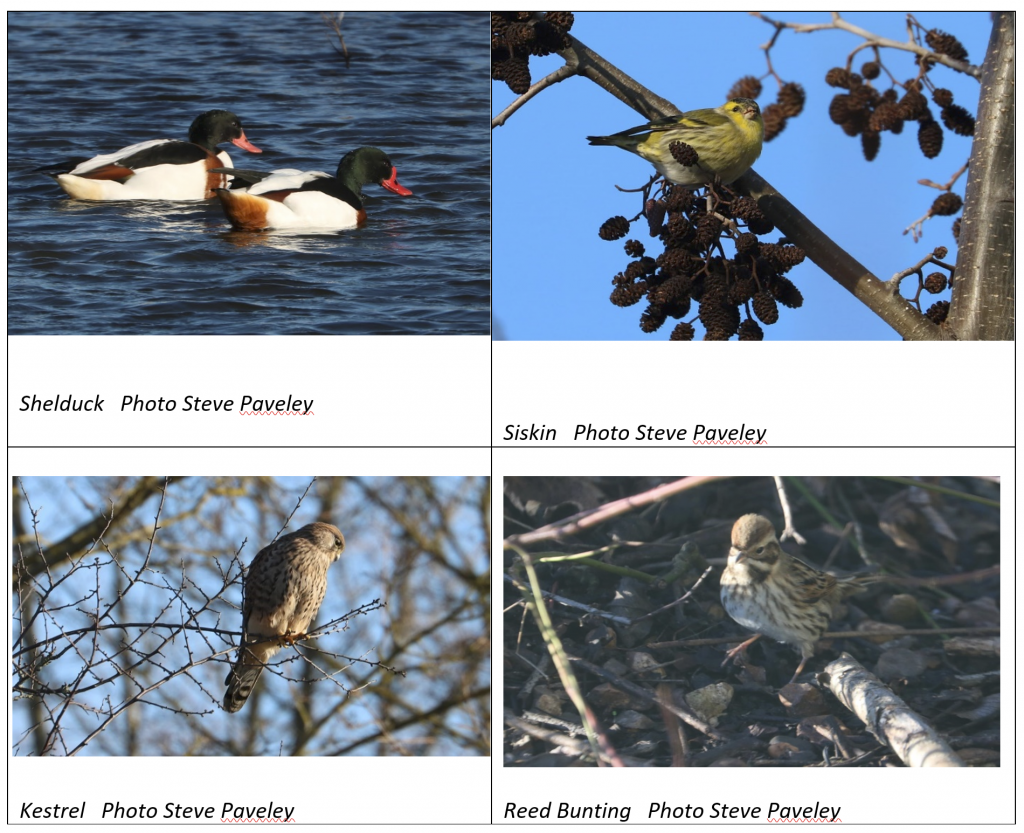
Many thanks to Steve Paveley for his superb photographs.
A very enjoyable walk with 42 species being seen.
| Greylag Goose | Tufted Duck | Grey Heron | Long-tailed Tit |
| Canada Goose | Great Crested Grebe | Common Kestrel | Common Starling |
| Mute Swan | Feral Pigeon | Peregrine Falcon | Eurasian Blackbird |
| Egyptian Goose | Common Woodpigeon | Ring-necked Parakeet | European Robin |
| Common Shelduck | Common Moorhen | Common Magpie | Stonechat |
| Northern Shoveler | Eurasian Coot | Eurasian Jackdaw | Dunnock |
| Gadwall | Northern Lapwing | Carrion Crow | European Greenfinch |
| Eurasian Wigeon | Black-headed Gull | Eurasian Blue Tit | Eurasian Siskin |
| Mallard | Common Gull | Great Tit | Common Reed Bunting |
| Eurasian Teal | Great Cormorant | Bearded Tit | |
| Common Pochard | Great Bittern | Cetti’s Warbler |
Andy Harding
Watermeads Nature Reserve – Sunday 10th December 2023
It is always a real eye-opener when visiting this small reserve, located within an ultra-urban location, with housing, a sports club, an industrial estate and water treatment plant to the Reserve’s boundary, all influencing the immediate environment. Despite the micro-location, it delivers some fantastic bird sightings, with the birds being very close and accessible.
12 eager birders walked the 2 mile route along the River Wandle with target birds of wintering Chiffchaff (potentially Siberian), Kingfisher, Grey Wagtail, Cetti’s Warbler and a good selection of waterbirds.
Starting from the London Road end, we made our way along the river path and almost immediately had a hunting Sparrowhawk appear from almost over our heads and crashed through the undergrowth, not to be seen again!
Good amount of birdsong was heard with the notable explosive song of a Cetti’s Warbler emanating from the deep scrub, although were fortunate to get some views of a further bird low-down in an overhanging willow later in the walk.
Also not seen but we heard the hoarse, trumpeting call of an Egyptian Goose, which are common here, along with the usual song birds of Robin, Dunnock, Blackbird, Song Thrush, Wren, together with Blue, Great and Coal Tits.
At the start of the route the usual water birds of Coot, Moorhen, Mallard are commonplace, but further along the river a greater variety is usually found – this walk produced Gadwall (male), Teal and Little Grebe (2).
A characteristic of this Reserve is that as you walk through Watermeads and continue through Poulter Park, the surrounding riverside vegetation seems to attract an increasing variety of passerines – we were not disappointed, connecting with 2 Common Chiffchaffs giving great views, along with Goldcrest (4), Goldfinches and four very obliging and photogenic Grey Wagtails.
As we walked back, a Grey Heron flew down river and landed on the bank, and a Kingfisher was heard but not seen, which was a shame as would have been a fitting end to a very enjoyable field outing.

Many thanks to Louise Kahan for her wonderful photographs.
In total 35 species were seen or heard:
| Egyptian Goose | Black-headed Gull | Common Magpie | Eurasian Wren |
| Gadwall | Herring Gull | Carrion Crow | Song Thrush |
| Mallard | Great Cormorant | Coal Tit | Eurasian Blackbird |
| Eurasian Teal | Grey Heron | Eurasian Blue Tit | European Robin |
| Little Grebe | Eurasian Sparrowhawk | Great Tit | Dunnock |
| Feral Pigeon | Common Kingfisher | Common Chiffchaff | Grey Wagtail |
| Common Woodpigeon | Great Spotted Woodpecker | Cetti’s Warbler | Common Chaffinch |
| Common Moorhen | Ring-necked Parakeet | Long-tailed Tit | European Goldfinch |
| Eurasian Coot | Eurasian Jay | Goldcrest |
Andy Harding
Tice’s Meadow – Sunday 5 November 2023
8 of us gathered at the entrance to Tice’s Meadow Nature Reserve, where we were met by Mark Elsoffer. It was a bright and sunny autumn morning which made a pleasant change to previous rainy visits.
Mark gave us a short history of the site and update as to where things are now. Then we set off through the woods to our first stop looking over the meadow. We saw the resident pair of Kestrels hunting over the field, and heard that Short Eared Owls have also been seen here.
We walked on through the woods to the hide on Horton’s Mound overlooking the fields and lakes. From here we were able to see Greylag and Egyptian Geese, Stonechats, Meadow Pipits and Pied Wagtails. A sharp-eyed member spotted a Peregrine falcon perched on one of the distant fence posts, and another got good views of 2 Green Sandpiper on one of the far shores of the lake.
As we left the hide, a Red Kite was seen circling and gliding overhead, as we walked towards the next main hide , over-looking the lake. Little Egret, Heron, Lapwing, Great Crested Grebe and Shoveller were on the water, and nearby the Peregrine was seen being mobbed by a Kestrel. Later we had good views of the Peregrine and Red Kite flying overhead.
Moving on, we reached the eastern end of the reserve and were able to access another area behind a gate, containing a lake surrounded by woods and scrubby areas. As we approached, a flock of around 100 Gadwall took off from the water.
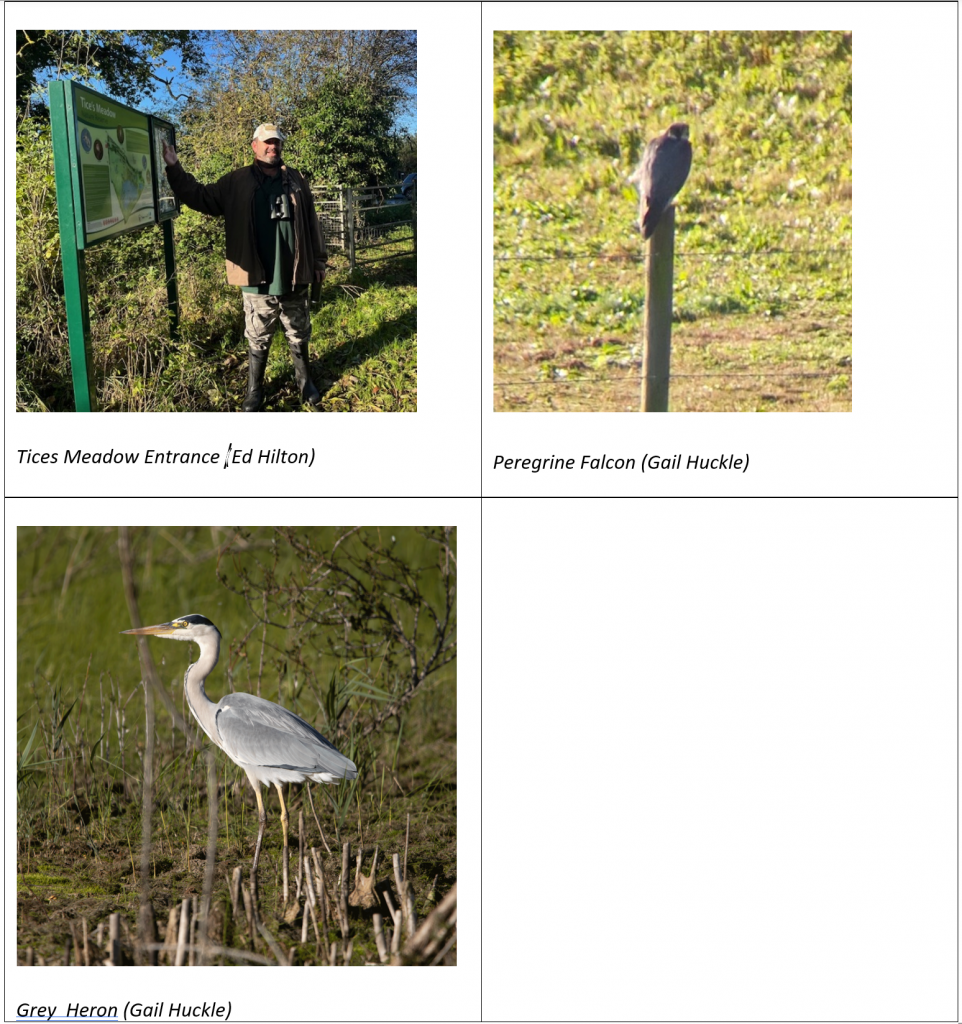
From here we made our way back along the muddy path, passing the stream and feeding posts to our right; Goldfinches and tits were feeding and a Grey Wagtail was on the path ahead. As we approached the end of the walk , alarm calls were heard from the bushes to our left and a Sparrow Hawk launched itself into the sky.
Overall, we had a very enjoyable morning and we thank Mark for showing us around.
The total number of species identified was 54:
| Blue Tit | Great Tit | Long-tailed Tit | Robin |
| Wren | Dunnock | House Sparrow | Starling |
| Blackbird | Song Thrush | Redwing | Goldfinch |
| Feral Pigeon | Wood Pigeon | Collared Dove | Stock Dove |
| Jackdaw | Carrion Crow | Magpie | Jay |
| Pied Wagtail | Grey Wagtail | Great Spotted Woodpecker | Reed Bunting |
| Cetti’s Warbler | Chiffchaff | Stonechat | Meadow Pipit |
| Kestrel | Sparrowhawk | Buzzard | Red Kite |
| Peregrine | Mute Swan | Canada Goose | Greylag Goose |
| Egyptian Goose | Cormorant | Grey Heron | Little Egret |
| Moorhen | Coot | Mallard | Tufted Duck |
| Shoveler | Gadwall | Teal | Little Grebe |
| Great Crested Grebe | Lapwing | Lesser Black-backed Gull | Green Sandpiper |
| Black-headed Gull | Herring Gull | TICE’S MEADOW |
Ed Hilton
Farlington Marshes – Sunday 1 October 2023
11 of us gathered for the start of our regular walk around this excellent nature reserve in Portsmouth; we were greeted by Dudley Cox (our local expert and leader), and set off along the coastal path that circumnavigates the reserve.
Passing the scrubby area to our left and with the sea to our right, we came to the first large inland body of water , surrounded by read beds, and containing a wide variety of waders and ducks. Highlights included a trio of Curlew Sandpiper, Green Sandpiper, Black and Bar-tailed Godwit, Snipe, Ruff and Water Rail (sculking in the background). There were glimpses of bearded tit and the sound of Cetti’s warbler was heard throughout the morning.
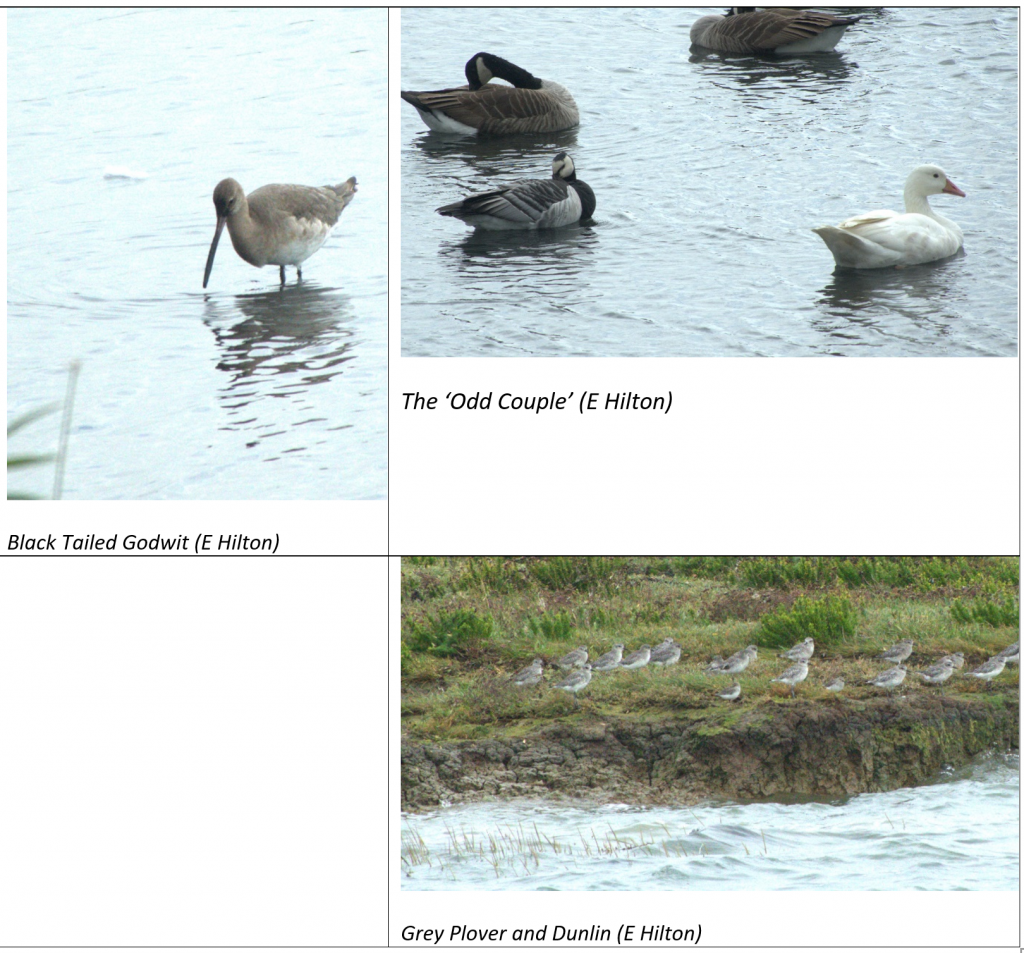
At one point the flocks were spooked by a Buzzard which was seen watching from a fence post behind the lake. Soon after, the local ‘odd-couple’ arrived (a Barnacle Goose paired with a white one) in amongst a small flock of Canada geese. We had an excellent vantage point on the raised path and several scopes to share amongst the group.
After spending some time here enjoying the views, we moved on into the harbour, seeing stonechat and meadow pipits along the way. Looking into the bay itself, we could see Oystercatcher, Curlew, Turnstone and Common Sandpiper. Much as we tried , we were unable spot the elusive whimbrel. As we rounded the end of the reserve, we stopped and looked out to sea where there are some long, low landed areas, covered in waders. Numerous curlew and oystercatchers stood on the shallow shore with dunlin in other areas; standing on the far end, away from the crowds, a Peregrine Falcon was seen standing and watching. At one point a flock of brent geese flew low across the water, and we were treated to a solitary Sandwich Tern drifting by, close in front of us.
We continued along the path around the reserve, and looked east towards Langstone. Sadly the ospreys which have been seen here, had recently left, but we had nice views of some Grey Plover, in one of their favourite spots. A lively discussion was had regarding the identity of the smaller waders amongst them: were they Sanderling or Dunlin?……and the conclusion was Dunlin.
We turned off the raised pathway and walked inland between some fields, looking for Cattle Egret and Wheatear but were not lucky this time. Reaching the lake to the left towards the end of the walk there were a variety of waders , including Godwit, Lapwing, Little Grebe and Shoveler.
Here some people left and others stayed to revisit the first waterbody that had yielded so much on the way out. Overall a very enjoyable and informative morning , with a total of 62 species seen. We thank Dudley for his company and leadership.
| Carrion Crow | Black- tailed Godwit | Black- headed Gull | Snipe |
| Lesser Black- backed Gull | Bearded Tit | Herring Gull | Ringed Plover |
| Starling | Grey Plover | Lapwing | Water Rail |
| Magpie | Greenshank | Little Egret | Turnstone |
| Curlew | Oystercatcher | Wren | Green Sandpiper |
| Kestrel | Barnacle Goose | Linnet | Great-crested Grebe |
| Meadow Pipit | Wood Pigeon | Stonechat | Peregrine Falcon |
| Buzzard | Sandwich Tern | Shelduck | Greylag Goose |
| Curlew Sandpiper | Little Grebe | Teal | Pheasant |
| Shoveler | Bar- tailed Godwit | Redshank | Greenfinch |
| Knot | Goldfinch | Widgeon | Blackcap |
| Moorhen | Long- tailed Tit | Canada Goose | Robin |
| Brent Goose | Skylark | Coot | Avocet |
| Mallard | Grey Heron | Pintail | Common Sandpiper |
| Ruff | Swallow | Dunlin | Cormorant |
| (Cetti’s Warbler – heard) | Great Tit | FARLINGTON MARSHES |
Ed Hilton
Beddington Farmlands – Sunday 3rd September 2023
A much-anticipated trip to visit Beddington Farmlands from within the perimeter fence was no disappointment, allowing everyone to see first-hand the amazing potential of this ultra urban reserve.
24 Surrey Bird Club members joined Zach Pannifer, who expertly led the Group around the Reserve.
Starting at Mile Road Gate, almost immediately a Great Egret was seen in the reed fringes of South Lake. What a start!
Making our way clockwise round the newly-created path, we spent some time viewing South Lake from a different perspective (normally via the hide from the perimeter path). The number of Grey Herons was noticeable with many first year birds the result of a successful breeding season. Tufted Duck, Coot, Northern Shoveler, Mallard and over-flying groups of noisy Gadwall made for a good start as we continued round to Phase III (an area of islands, scrapes, open water and ditches).
This is always a very productive area, which did not disappoint with Little Ringed Plover, Greenshank and Green and Common Sandpiper. Plenty of gulls were also present mainly Black-headed and Herring, but two Great Black-backed Gulls were within the flock.
There was plenty of passerine movement with Yellow Wagtail, Meadow Pipit, Linnets and Goldfinches calling overhead. A good array of warblers were also seen including Reed, Chiffchaff, Whitethroat, Blackcap and “heard but not seen” Cetti’s.
Heading back into the centre of the Reserve, over The Mound, we were treated to a real raptor-fest with up to 7 Common Buzzards taking to the thermals, with a supporting cast of two Kestrels and a Sparrowhawk, and as we went further north towards the Phase I Grasslands, two Peregrines (which reside around the Incinerator and pylons) took to the skies and displayed beautifully. To add to the excitement Zach called out a hawking Hobby over the Grasslands to make for a special 20 minutes.
Stopping off at North Lake, many of the usual wildfowl were in good numbers along with a Shelduck and Lapwing.
A tremendous morning with a superb array of birds. Our thanks to Zach for leading and Charlie Owens (Reserve Warden) who arranged the visit for SBC. In total, 52 species were seen:
| Canada Goose | Eurasian Coot | Eurasian Sparrowhawk | Common Reed Warbler |
| Mute Swan | Little Ringed Plover | Common Buzzard | Common Chiffchaff |
| Common Shelduck | Northern Lapwing | Common Kingfisher | Cetti’s Warbler |
| Northern Shoveler | Common Sandpiper | Great SpottedWoodpecker | Eurasian Blackcap |
| Gadwall | Green Sandpiper | Common Kestrel | Common Whitethroat |
| Mallard | Common Greenshank | Eurasian Hobby | Eurasian Wren |
| Eurasian Teal | Black-headed Gull | Peregrine Falcon | Common Starling |
| Tufted Duck | Herring Gull | Ring-necked Parakeet | European Robin |
| Little Grebe | Great Black-backed Gull | Eurasian Jay | Western Yellow Wagtail |
| Feral Pigeon | Great Cormorant | Common Magpie | Pied Wagtail |
| Stock Dove | Little Egret | Eurasian Jackdaw | Meadow Pipit |
| Common Woodpigeon | Great Egret | Carrion Crow | Common Linnet |
| Common Moorhen | Grey Heron | Great Tit | European Goldfinch |
Andy Harding
